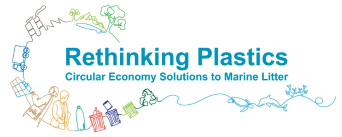Promoting Innovative and Sustainable Packaging
Kim Castillo and her colleagues have been busy. At the Philippine Center for Environmental Protection and Sustainable Development, they understand that billions of plastic items are ending up on the country’s streets and coastlines every year, and impacting fisheries and agriculture.
Composting Video Series Episode 1
That’s why they’re working to create a future without single-use plastics. In this pilot project, they’ve made a vital contribution: “Our work involves promoting sustainable packaging in order to reduce marine litter in the Philippines,” Castillo explains. “At the start of the project, we connected up with as many leaders, producers, manufacturers and businesses owners as possible in order to build relationships and hear their perspectives on sustainable packaging. We shared knowledge and understanding – and developed criteria for an ecolabel.” This voluntary standard certifies sustainably produced packaging, whether it’s biodegradable, reusable or recyclable, and guarantees that a recovery system is in place. The label considers the entire product life cycle, requiring manufacturers to use resources efficiently and manage their waste properly. With markets and consumers increasingly demanding environmentally friendly solutions to plastic pollution, there’s never been a better time to introduce an ecolabel for sustainable packaging. The label means that manufacturers are made more accountable in terms of their environmental credentials, and it encourages consumers to use more environmentally friendly products, while stimulating innovation and market development.
WHAT HAVE WE ACHIEVED?
1. Developing an ecolabel
The ecolabel Green Choice Philippines certifies that the packaging used in a product is sustainable. This encourages reuse, recyclability and a shift to sustainable alternatives to single-use packaging. To create the label, we started by analysing market readiness for sustainable packaging in Bacolod and Iloilo City, and compared local standards, policies and best practices with the international context. Based on the results, we developed a first set of ecolabelling criteria. After multiple reviews, the criteria were validated and finalised in March 2022 by the Technical Committee – a group of representatives from government, the private sector, academia and civil society. This committee recommended the standard to the National Ecolabelling Board, which is jointly chaired by the Department of Trade and Industry’s Bureau of Philippine Standards and the Department of Environment and Natural Resources. The Green Choice Philippines criteria certifies that packaging is biodegradable, compostable, reusable, refillable or recyclable – and that recovery systems are in place. We have shared the criteria with packaging suppliers and manufacturers and brought certification of the first three applications from Happy Green Packaging, Sustainable and Compostable Horizons Industry Group Inc. (SACHI) and Zero Plastic Philippines on the way. Once certification has been awarded, consumers will be able to scan the label on certified packaging to learn more. The criteria will then be reassessed every two years.
2. Bringing the private sector up to speed
To inform the retail sector about the ecolabel, we developed a private sector roadmap for sustainable packaging. It outlines the challenges and impacts of sustainable packaging, provides strategic plans and proposes solutions for shifting to more sustainable packaging.
3. Reaching hundreds of people
An information campaign on sustainable consumption and production targeted a wide range of actors from government, private firms such as packaging suppliers and manufacturers, and consumers. In seminars and on social media, we reached more than 1,700 people from business and industry with information on the advantages of ecolabelling and its market incentives.
HOW DO WE RECOMMEND TAKING THIS INITIATIVE FORWARD?
- Private sector and industry actors can now implement the private sector roadmap on sustainable packaging.
- National and local government should integrate ecolabelling criteria into policies, support green public procurement and sustainable consumption and production, and fully maximise the label’s potential to support sustainably produced packaging products in the country.
- Producers and manufacturers of packaging should invest in the technology and production of alternative packaging products in keeping with the requirements specified in the ecolabel criteria for packaging.
- Expand information and education campaigns and use social media to engage more stakeholders and consumers.
Implemented by:
Philippine Center for Environmental Protection and Sustainable Development, Inc. (PCEPSDI)/ https://pcepsdi.org.ph
Twitter: Green Choice Philippines (@PCEPSDI) / Twitter
Facebook: Phil.Center for Environmental Protection and Sus. Devt.,Inc | Facebook
Related Documents
- PCEPSDI-Private-Sector-Roadmap-to-Sustainable-Packaging.pdf
- PCEPSDI_Comparative_Study_Report_on_Sustainable_Packaging.pdf
- PCEPSDI-Market-Readiness-Study.pdf
- PCEPSDI-Policy-Recommendation-Guidelines.pdf















